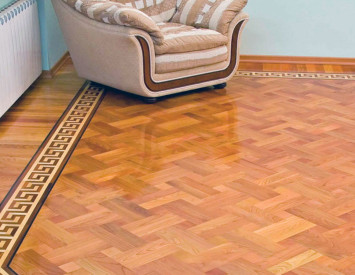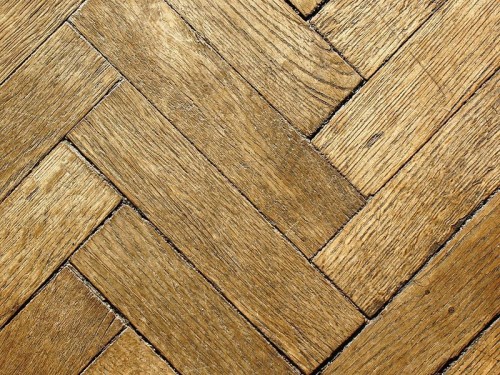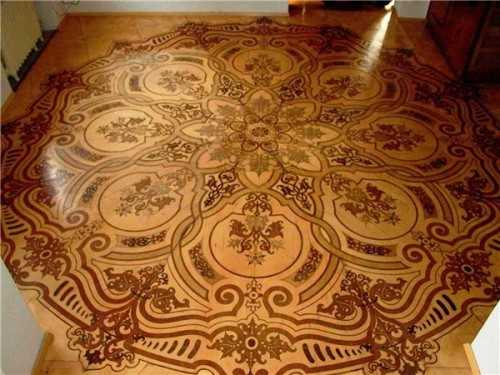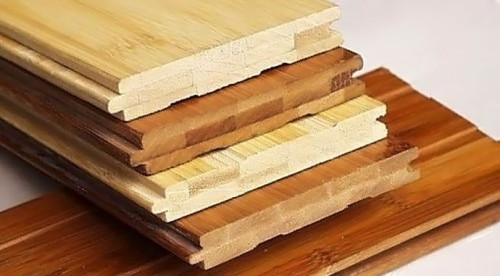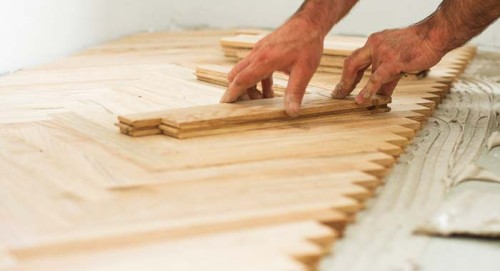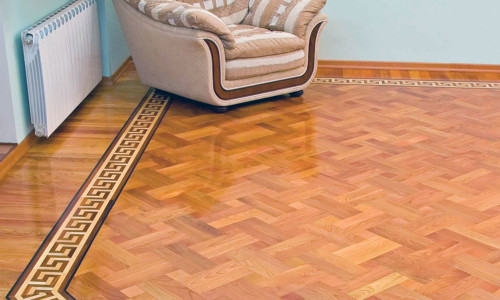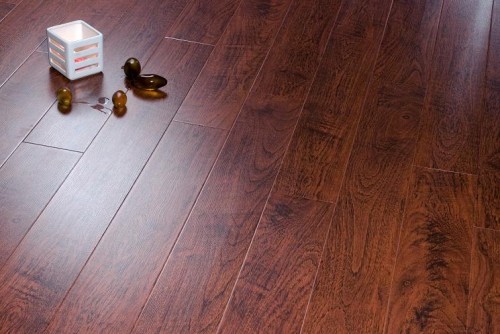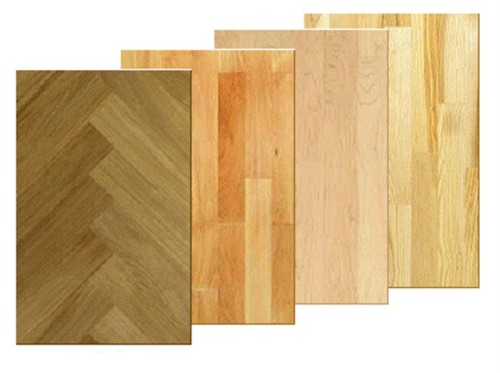Wooden floors from oak rivets, which are a prototype of modern parquet, were able to make back in the 16th century. Today, parquet is considered one of the main flooring. In general, for modern parquet there is a rather high requirement in terms of production. So, not all breeds of trees are suitable for its manufacture. The main requirements for the material are parameters such as wear resistance, reliability and hardness. The most suitable for the manufacture of a parquet board are red and black oak, ash, olive, Kambas, acacia, kumaru and walnut.
Parquet is valued for the ability to maintain heat, as well as for the environmental friendliness and simplicity of care. However, the material is "afraid" of an excess moisture in the room. The fact is that increased humidity leads to deformation and loss of appearance. Moreover, most susceptible to wear the edge of parquet planks. To increase wear resistance, as an option, the wood can be made denser and firmly by means of pressing. Next, we will tell you more about the types and features of the parquet board.
Types of parquet
There are several varieties of parquet boards:
Piece parquet. Mounted quite simply. This type of parquet is typed from piece bars of a certain size. Their length is 20-60 cm, width 4-10 cm, and the thickness is about 15 mm. At the same time, each bar has special longitudinal grooves and crests that allow you to adapt the parquet rails among themselves during the installation of the floor. The material for this parquet is usually inexpensive wood species, for example, oak, cherry, ash, maple, acacia and walnut. Therefore, an average of 20 to 60 dollars is asked in a square meter in construction stores.
Parquet of this type varies in the drawings of the cut:
- Parquet of the Universal brand has a diverse ornament and small knots.
- Mark Parquet with alternating small knots is called "natural."
- The Classic brand has an unusual floor pattern resembling the texture of the wood itself.
- The Parquet of the Chest Brand has a homogeneous small ornament.
- “Guest” - has a mixed cut with contrast.
- Mark Parquet with different colors of parquet boards is called "Antik".
If we compare the floorboard with the sexual, then the parquet has a spoon and a comb on the ends. In addition to the layer of varnish, which covers the surface of the parquet racks, they do not have additional protection that provides rigidity. With proper operation, this floor covering can last up to 80 years. For this, at least it is required that the humidity in the room is not above 30%. The piece parquet is usually laid in corridors or living rooms.
Set Parquet. Refers to the types of shield parquets. It is sometimes called a mosaic type of parquet. For its assembly, 400 × 400 mm or 600 × 600 mm strips are used. Combining the positions of parquet rails allows you to lay out a variety of patterns. This coating is usually laid on a concrete or wooden base using glue. It can be attached to a hard or soft basis. Glane for the first option is made of expensive wood. At the same time, grooves and spikes are made in them. They provide dense adhesion of parquet planks with each other. For fastening to the flooring, nails are used. Parquet, which is the basis of a solid rail, is quite complicated in manufacturing, which has become the reason for its rare use recently. A sketch parquet is considered cheaper and simple in production, which is based on a soft rail. He has grooves from all sides, and laying is carried out using rivets.
There are parquet strips with a bracket. They have a slightly mowed edge around the perimeter. There is also a type of parquet with a fold. He has special seams from all four sides. This type of material is fixed using mastic. This flooring is considered the most durable in its class. It should also be said that the characteristics of the setting parquet are similar to the features of the shield flooring. Moreover, it has more diversity in shades and textures.
Artistic parquet. The price of this material is quite high. This type of flooring is complicated not only in production, but also in the design plan. Therefore, such a parquet refers to the elite class. It is used to lick the floors in art galleries, museums, large hotel complexes, etc. In order to make this type of parquet, several wood species are used, which differ in color scheme and texture. Most often it is ash, oak (oak parquet), maple, as well as a red and black tree. In order to put this type of flooring, a special scheme is prepared in advance based on the area of \u200b\u200bthe room. Artistic parquet can "boast" with high operational properties. So, in particular, it is resistant to high humidity and temperature changes. The production of this parquet is similar to the manufacture of a thyroid and setting flooring. Its plates often make a rather complex shape. At the same time, they glue and compress with each other. An example of such a material is a two -component parquet.
Parquet shields. The technology for manufacturing this parquet has existed for a long time. The base of this flooring is made of boards or wood plates. The length and width of the shields can vary from 40 to 80 cm. At the same time, the floor thickness is only 6-9 mm. In the production of this coating on the wood base, strips are glued, usually made of solid wood. Typically, parquet strips of this species are covered with several layers of varnish in the production process. It is also worth noting that they are quite complicated in styling. The most important thing is to withstand a right angle. If this is not achieved, then gaps will remain between the shields. The process does not even facilitate the presence of spikes and grooves in the design. Due to the fact that the thickness of the parquet shields is small, they can be laid directly on the old coating.
The shield parquet consists of three layers. At the same time, two lower layers are several wood fibers that are located perpendicular to each other. The upper layer is particles of high -quality wood. In this case, its thickness is usually about 3-4 mm.
By type of base, several categories of parquet shields are distinguished:
- One of them is a parquet with a frame base, which has a special strapping around the perimeter. At the same time, in the grooves of the strapping for each spike, the so-called Reiki-fillers are fixed.
- In addition, there is a type of parquet in which the base is represented by two rails.
Parquet shields are also distinguished by the type of facing coating. It can be from:
- Shuddy veneer.
- Strict veneer.
- Plywood.
- Facing tiles.
All varieties of a shield parquet coating are largely similar in their characteristics. All of them are quite strong, but at the same time they are quite sensitive to various temperature differences. If you maintain a normal temperature regime, then this type of flooring can last up to 75 years. This type of parquet is best used in public rooms where constant temperature is held, and the floor is experiencing high loads. In addition, this flooring is also suitable for the living room.
Rules for choosing material
First of all, you need to make sure that there is a certificate. You should ask the seller to provide you with this document before the purchase of the parquet. The presence of a certificate gives a guarantee of the quality and durability of the material.
When choosing the material, it is still worth paying attention to its cost. When calculating the costs of installing the parking, summarize not only the price of the material, but also the cost of work. It is possible that an economical option at first glance will cost more than the one that seemed to you, at first glance, expensive. It should be borne in mind that in addition to the parquet board itself, varnish and substrate will be required. All these are additional financial costs. Therefore, it is sometimes more profitable to overpay, but to buy a parquet in a finished form, and not to purchase related material separately and perform additional work.
Also, when choosing, it is necessary to provide such a criterion as humidity. For natural parquet, it is approximately 10%. In order to measure the humidity level, you will need special equipment and some skills. But this is not necessary. It is enough to recognize the seller with the humidity of the material you are interested in. If the value of this parameter exceeds 10-11%, then such material should not be bought. High -quality parquet should be well dried. This is easy enough to check. To do this, knock on the bar. The dried parquet will hear a characteristic sonorous sound.
When choosing a parquet board, be sure to take into account its geometry. To check this criterion, you can take two strips and fold them perpendicular. All aspects of the material should be even.
When choosing a parquet, you need to make sure its environmental friendliness. Bamboo is considered the safest material. Another good option is a cork. Environmental friendliness of the parquet from other materials can be determined by smell. High -quality wooden parquet should smell of wood. There should be no smells of chemicals. If the smell of chemistry is present, then it is worth abandoning such a material.
Installation work
Previously, the material should undergo acclimatization in the room where it will be used. To do this, the parquet should be held in a plowed form of 1-2 days. Next, you can start work on laying the coating.
Installation procedure:
- First of all, you need to remove furniture, extraneous things and garbage from the room. In addition, old skirting boards and flooring should be removed. The bare floor must remain.
- After that, you need to level the surface of the base. In the case of a concrete floor, a screed is used for this purpose.
- When the screed dries, you can start applying the soil. While the screed dries, a plywood sheet is prepared in advance, which needs to be cut into four parts. They will act as a substrate. They should be attached to the base. This can be done with glue or mastic.
- When the plywood is settled, it should be polished.
- After that, you can start laying the flooring. It should be said that these boards are allowed to be laid in different directions, thereby achieving different drawings.
- Installation should begin from the wall. In the process, each bar is smeared with glue and applied to the base. Additionally, they are strengthened with nails.
- When the parquet board is laid, you need to polish the floor and varnish. The varnish is applied in several layers. It is best to use a spatula or roller for this. It is important that the next layer is applied only after the previous one is drying well. When this is done, we make the last stroke - we mount the plinth into place.
